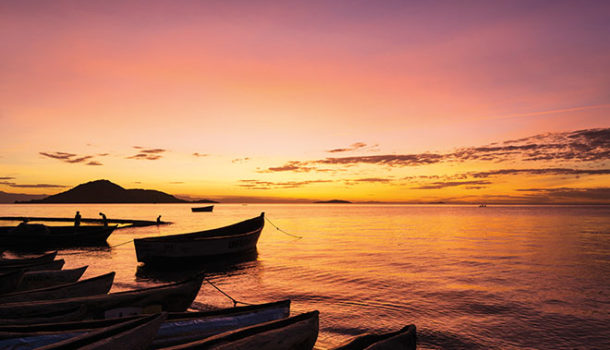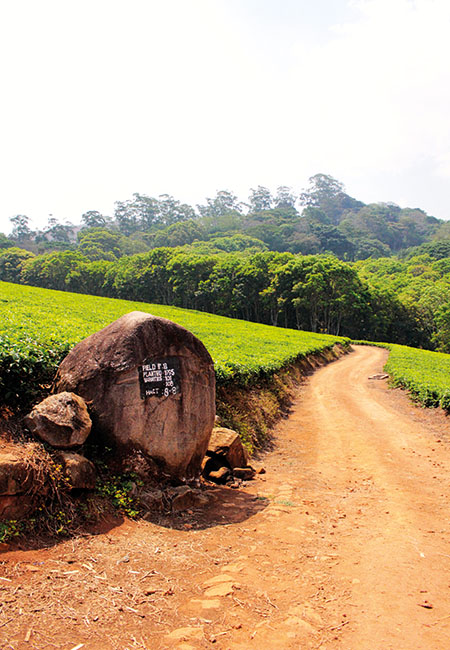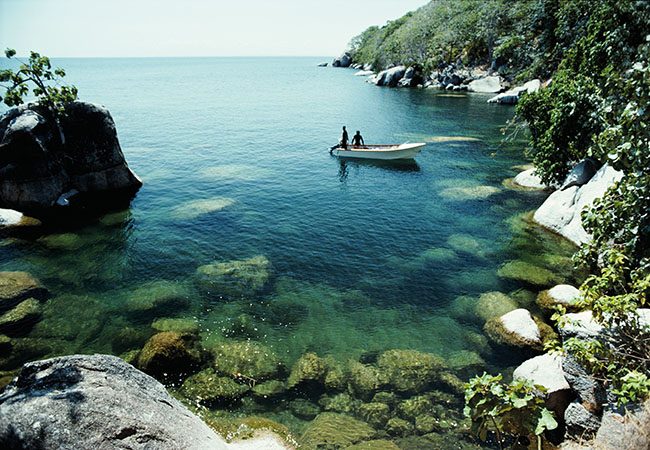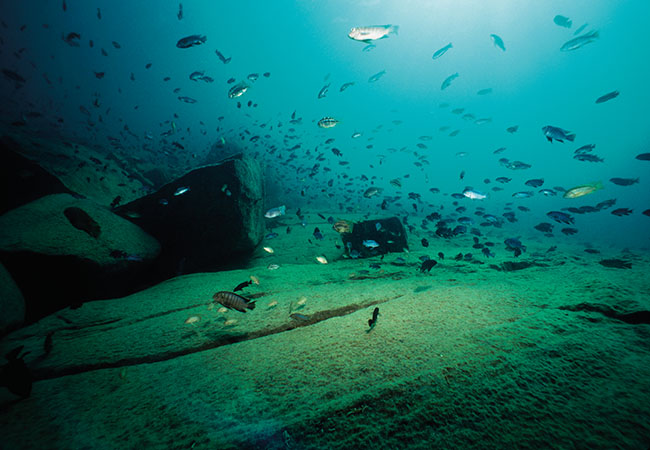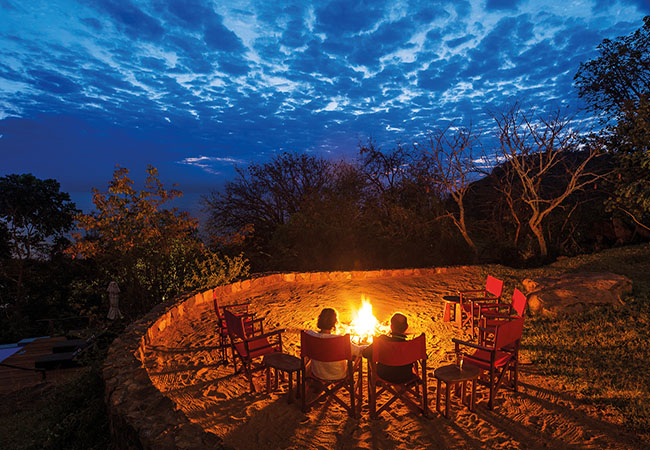Wedged between three giants – Tanzania, Mozambique and Zambia – the sleek sliver of Malawi is easily overlooked. But, says Keith Bain, for a tiny nation, it has a lot of soul
DOWN BY THE WATER
‘Do you want a gentle cruise or should we go very fast?’ asks Matt, our Malagasy skipper who, with his barefoot two-man crew, has just carried our luggage across the wide beach through knee-high water and deposited it on the high-tech speed-boat. It’s moored in front of Whistlers Fishing Club, where we’d been waiting at an open-to-the-elements bar that sells samoosas for 300 kwacha.
Children played along the shoreline, which was dotted intermittently with ancient, sun-baked fishing boats. Ahead of us, the water reached the horizon – I had to remind myself that this was a lake and not the ocean.
‘Really fast!’ we responded, so Matt gleefully told us to hang on tight. Then he cranked up the engine and took us buzzing into the distance, spray cooling our faces as we glided over the water. Our ride was interrupted only briefly when, suddenly, five-or-so hippos poked through the surface and glared at us with bewildered expressions, suggesting their afternoon naps had been interrupted.
We changed course and soon arrived at Blue Zebra Island Lodge, our lodgings on Nankoma Island, one of three that make up the Marelli Island archipelago. It’s a tiny pinch of paradise inhabited by blue-tail skinks, sun snakes, African fish eagles and spotted eagle owls.
Matt’s French wife, Estelle, showed us to our semi-canvas suites perched near the water’s edge, with bathrooms built into the rocks and gigantic gauze nets suspended over the beds. Just minutes later, we were climbing into kayaks and paddling our way around the island, admiring its luxuriant vegetation and bustling birdlife and, every now and then, bumping into tiny boats whose half-naked fishermen would try selling us their day’s catch.
The southernmost of the Rift Valley’s great lakes, Lake Malawi is 75 km wide and almost 600 km long. Conservative estimates suggest that it contains around 500 species of fish more freshwater species than in all European and North American lakes combined. More likely, that number is closer to 1 000 most of which will be endemic, and most of which are cichlids, one of the few fish families that care for their offspring. Of the four kinds of cichlids found here, it’s the brightly-hued mbuna that draw snorkelers and scuba divers to the lake. Another cichlid group known as chambo (a type of tilapia) tend to be considered Malawi’s best-tasting fish.
And it’s chambo that’s later served at dinner, before we drift to sleep with the lake’s gentle waters sloshing against the rocks close by. Days on the island were given over to more kayaking and boat rides, and languid hours drifting about wearing snorkelling gear, staring at the ceaseless underwater parade. It was only later that I read the note in my room saying that crocodiles are occasionally spotted around the island – but only after heavy rains wash them down the river.
It was while chatting to one of Blue Zebra’s waiters that I learn more about Lake Malawi’s surprisingly turbulent history. Although it began appearing on Portuguese maps soon after a trader mentioned a ‘lake which looks like the sea’ in his journal in 1616, it was David Livingstone who popularised it as ‘the Lake of Stars’ supposedly because of the dazzling panorama of hundreds of fishermen’s lanterns dotting its surface after dark.
During the 1800s, Malawi became a hub of East Africa’s tyrannical slave trade it was a time when women and children were captured during violent raids and then transported across the lake before being shipped to the slave markets on Zanzibar.
Livingstone, who arrived here for his disastrous Zambezi Expedition in 1858, was deeply shocked by what he saw. His reports are ultimately what persuaded the British government to take action against slavery in the area, even convincing the Sultan of Zanzibar to ban the trade in humans entirely.
Today, boats of every description still cruise the lake, but the humans being ferried across now tend to be passengers aboard the Ilala, used for longer trips, such as ones to Likoma Island, a 17 km² island where the main attraction is surprise, surprise snorkelling in waters teeming with colourful fish, or simply soaking up the sunshine on pristine sandy beaches.
HIGHLANDS
Chip Kay is eccentric and practical in equal measure. The patriarchal owner of Satemwa lords it over vast tea plantations, in the Thyolo Highlands, not far from Blantyre, Malawi’s main commercial hub.
Satemwa was founded in 1923 by Chip’s father, Scot Maclean Kay, who’d been a rubber planter from Malaya after emigrating from Ayreshire in Scotland.
With its long history, family-owned, Fairtrade-registered Satemwa produces teas that end up in global brands such as Tetley and Five Roses. Rarer artisanal teas are also cultivated, and since 1971, coffee has been grown, too.
Tea, says Chip, is the only settler crop that has had any lasting impact in the region; it has been grown in Malawi for more than a century. Across the area, neat green bushes blanket the undulating hills, growing right up to the edge of the road.
Chip, a relentless raconteur, uses words like ‘kinky’ a lot and calls a spade a spade when he gets on to politics. He tells us that David Livingstone married into his mother’s side of the family, and that it was all thanks to Hastings Banda that Malawi was the last country in the world to have TV.
Throughout dinner, and again the next day at breakfast, Chip – now deep into his eighties, but as vital as a teenager – regales us with swashbuckling stories that happen to be true, plus dangerous opinions and very outspoken gossip. We enjoy a very long-winded, colonial-style breakfast on the veranda of Huntingdon House, his family’s original home set within a spectacular garden at the edge of the plantation. The homestead is now an exclusive guest house packed with colonial antiques and lingering Old World ambience.
After his sixth cup of tea, Chip packs us into his feisty 4×4 and takes us on a full tour of the estate, pausing every now and then to check that everything’s running smoothly. We pass on through an undulating landscape carpeted with waist-high bushes where, Chip tells us, tea-pickers will each pluck 100 kg of leaves on an average high-season day.
After a cursory stop at the estate’s Arabica coffee-plant nursery, we go for an in-depth tasting at the tea factory built in 1937 where leaves from bushes grown over 890 ha are processed, mostly as black, single-estate teas. Some 2 500 tons of black tea are produced per year, but there is white tea, green tea, oolong, and Earl Grey too … around two dozen varieties that we sample back-to-back.
Time at Huntingdon isn’t only about tea, however. We are told to explore as widely as we can either by mountain bike or with a guide who takes us on a quick walk through a tiny section of protected indigenous forest. ‘Somebody has to protect the forest,’ explains Chip, a bit cynically.
On clear days, it was possible to see Mulanje Massif, Malawi’s tallest peak, from the estate. Mulanje, a source of myths, legends, and incredible hikes, was just 90 minutes from the estate and a great challenge for the hikers among us.
Known as Chilumba mu Mlengalenga ‘Island in the Sky’ it rises 3 002m above sea level and was blanketed by clouds when we reached it. Our guide explained that the enormous granite massif was one of several free-standing eroded mountains, commonly known as monadnocks or inselbergs (literally ‘island mountains’) scattered around the southern end of the Great Rift Valley.
Our guide also revealed to us that JRR Tolkien had visited Mulanje in the 1930s, and was so inspired by its magic and beauty that he used it as a backdrop for The Hobbit. ‘It’s the Lonely Mountain, where Smaug lives,’ he said, adding dramatic flourishes as we stared at him, wide-eyed.’
When we were travelling back to Huntingdon, however, Chip laughed and explained, ‘It is a well-documented fact that Tolkien hardly ever left the British Isles. When an adult, he never travelled outside Europe.’
What a shame, I thought. He would have loved it here, in a country full of scintillating scenery, solitary mountains and imaginative storytellers.
GAME DRIVE
There’s more to Malawi than being slung out in a hammock on the lake shore or sipping tea on the veranda. With around a dozen national parks and several more protected forests and other wilderness areas, Malawi is steadily becoming a destination for land-based wildlife too.
It’s a bold move, indeed, considering that, by the 1990s, the country’s parks had almost entirely collapsed owing to wide-scale poaching, lack of resources and neglect.
In 2003, though, thanks to a landmark deal, Majete Wildlife Reserve, situated between Blantyre and Lake Malawi, was put under the management of African Parks, an international non-profit with an interest in rescuing failed reserves and rehabilitating them into sustainable conservation tourism ventures. With the poaching having reached critical levels in the 1980s, by the time African Parks took it over, this rugged reserve had become bereft of animals. Immediately, the organisation put up border fencing, strengthened security and introduced more than 2 500 animals to recreate a thriving ecosystem as part of a decade-long rehab programme.
The turnaround has been breathtaking. By 2012, the reserve was in such good condition that lions were translocated to Majete, effectively making it Malawi’s first big five destination. Animal populations are thriving, and the restoration of this park with its variety of habitats, including ancient baobabs, rivers full of crocs and hippos, and groves of star chestnuts, has prompted safari maven Robin Pope to establish an exclusive lodge inside a concession in the reserve. With large elephant numbers, maturing lion litters and a new pride being introduced this year, sightings are excellent, with the additional benefit of the park avoiding ‘Krugerisation,’ as local rangers like to refer to the over-commercialisation of wildlife parks.
With Majete’s rehabilitation being so successful, the park has fast become a blueprint for the fight against poaching, and after years of coaxing, the Malawian government last year convinced African Parks to assume management of two more of the country’s reserves.
Further up the Shire River is Liwonde National Park, a fairly small but abundant and beautiful reserve, dominated by the presence of a wide, meandering stretch of palm-lined river. Based at Mvuu Lodge, where pathways lead to huge wood-and-canvas suites right in the thick of riverine forest, bush walks and game drives are possible, but the park is best known for its lazy boat-safaris, when pods of hippos and masses of basking crocodiles are spotted, and elephant herds are seen swimming across the river. Within the park’s rhino sanctuary, there is also a magnificent below-ground hide at a large waterhole, where it is possible to spend hours riveted by scenes of elephants going through their highly social ritual of bathing and drinking.
Also now making a comeback from the brink of total collapse is Malawi’s oldest national park, Nkhotakota, a vast wilderness just 30 km from Lake Malawi, but nearly unknown to the outside world. Here, one maverick conservationist from the UK, David Cole, has been operating Tongole Wilderness Lodge, an exclusive place to escape to, but where animal populations have been decimated by many years of poaching.
Cole established the lodge to channel tourism dollars into local communities, and has for years warned guests that they weren’t guaranteed much wildlife.
But this, too, is changing. Ever since African Parks assumed management of the reserve last year, the park has been fenced, security personnel deployed, roads cut, and tsetse fly control schemes introduced. If all goes to plan, the park will become an elephant sanctuary, and some 500 will be translocated here from Majete and Liwonde in the middle of this year. Word on the ground is that it will be the largest translocation in history, giving both Nkhotakota and the animals a new lease on life, and taking Malawi’s bid to be a safari spot to the next level.
GOOD TO KNOW
When to go
June through August is perfect, when it’s dry with warm days and cool nights. Many lake resorts close down during the rainy season between December and March.
Getting there
Malawian Airways and SAA both fly from Johannesburg to Blantyre and Lilongwe.
Visas
South African passport holders can visit visa-free for 30 days.
Money
Malawian kwacha (1 ZAR = 45 MWK) can be obtained at airports and cities from ATMs (Visa only) or banks/money changers; Visa credit cards may be accepted, but should not be relied upon outside large towns
Health
Take precautions against malaria and ask about bilharzia before swimming in Lake Malawi – the parasitic flatworm is found in human-populated areas. Your medical insurance should preferably cover emergency evacuation.
Getting around
Public transport is limited. Relatively decent roads make Malawi viable for self-drive visits, though rentals can be expensive and roadside assistance unreliable. Planned itineraries with a tour operator are recommended.
Where to stay Nankoma Island’s Blue Zebra Island Lodge has a boutique- island-resort feel, and there is almost no one else on the island. There are just 12 chalets, tents and tented chalets, with wonderful water views, a private beach, a pool, masseuse, kayaks, snorkelling equipment, and excellent meals. Boat transfers are included in the rate, which starts at $135 per person.
www.bluezebra.mw
Aside from Robin Pope’s Mkulumadzi Lodge (www.robinpopesafaris.net), which is magnificently situated within its own concession in Majete Game Reserve, African Parks runs the somewhat rustic Thawale Lodge (+26 599 952 1741, thawale@african-parks.org), with safari tents overlooking a waterhole that’s marvellously busy at dawn. There’s also a camping site (with more planned), as well as self-drive game trips within Majete.
Mvuu Wilderness Lodge is set on the banks of a lagoon off the Shire River within Liwonde National Park. There are only eight enormous tents, each with their own viewing decks overlooking the lagoon.
www.cawsmw.com/index.php/lodges/mvuu-lodge/
Within the resuscitating Nkhotakhota National Park, Tongole Wilderness Lodge is a marvellous escape from the modern world, albeit a pretty luxurious escape with game drives vying with gentle walks, guided hill climbs, and canoe rides, all topped off with gin and tonics served on the riverbank. Elephants can usually be seen from the lodge’s vast deck, which overlooks the reserve’s main river.
www.tongole.com
Built in the mid-1930s, Huntingdon House is a quintessential colonial-era planter’s homestead, packed full of personality and beautifully refurbished so that it’s as much of a time-trip as it is a base from which to explore the tea- and coffee-growing estate on which its set. A second overnight option, Chawani Bungalow, is also on Satemwa Estate.
www.huntingdon-malawi.com.
In Lilongwe, the best place to stay is in one of nine rooms at Latitude 13°, Malawi’s first boutique hotel. Combining eye-catching decor styles with innovative architecture, it’s a slightly unlikely oasis in the quiet capital, generally associated with diplomats and NGOs.
13.latitudehotels.com
Photography Keith Bain, National Geographic, courtesy images
(This article was first published in the winter 2016 issue of AA traveller magazine)

